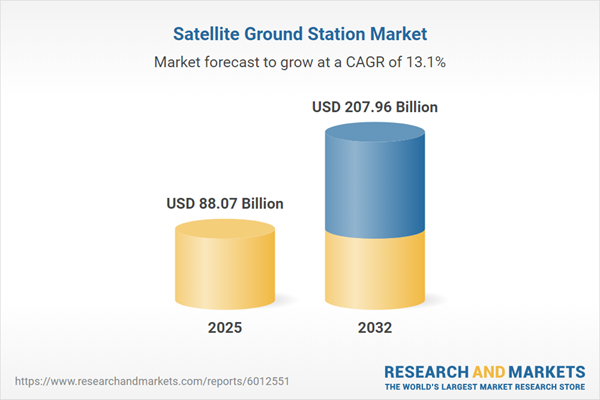Speak directly to the analyst to clarify any post sales queries you may have.
The satellite ground station market is at the foundation of global digital connectivity, allowing enterprises and public sector organizations to support evolving communications strategies and ensure network resilience. Senior decision-makers increasingly recognize robust satellite infrastructure as central to operational agility and competitive advantage.
Market Snapshot: Satellite Ground Station Market Growth
Growth in the satellite ground station market is fueled by widespread digital transformation across government and commercial sectors, with organizations seeking to modernize existing communication systems and tackle emerging security challenges. Modern ground stations serve as critical nodes in maintaining uninterrupted data flow, enabling real-time decision making and adaptive business development. Strong demand for secure, high-speed broadband and greater network reliability is driving competitive innovation among providers. These advancements support a broad array of applications in defense, scientific research, and media broadcasting. Meanwhile, shifts in regulatory policies and evolving technology frameworks push industry leaders to revise their connectivity approaches, ensuring their networks remain robust against global challenges.
Scope & Segmentation of the Satellite Ground Station Market
Strategic planning in the satellite ground station market relies on a deep understanding of the technologies, applications, and user requirements shaping sector demand. Insight into segmentation helps organizations identify opportunities aligned with their operational objectives.
- Frequency Bands: C-Band, Ka-Band, Ku-Band, S-Band, and X-Band enable secure broadband, mission-critical command, and specialized communications across industries including defense and broadcasting.
- Antenna Types: Fixed, mobile, and transportable antennas deliver solutions for permanent, temporary, and responsive deployments, aiding rapid disaster response and continuous site operations.
- Service Types: Broadband, narrowband, telemetry, tracking, control, and integrated testing services address the communication needs of research institutions, government agencies, and broadcasting hubs.
- End Users: The market serves broadcasters, internet providers, telecom operators, defense sectors, public administrations, and research bodies—each requiring compliance with compliance frameworks and specialized mission delivery.
- Installation Modes: Indoor and outdoor installations enhance the adaptability of ground stations, supporting operations in controlled environments and remote or rugged field locations.
- Geographic Regions: Distinct operating landscapes in the Americas, Europe, Middle East & Africa, and Asia-Pacific shape infrastructure needs, regulatory parameters, and growth prospects, influencing strategic entry and local investment plans.
- Industry Participants: Companies including Comtech Telecommunications Corp., Viasat, Inc., Hughes Network Systems, LLC, Gilat Satellite Networks Ltd., Kratos Defense & Security Solutions, Inc., ST Engineering Ltd, General Dynamics Corporation, Honeywell International Inc., Rohde & Schwarz GmbH & Co KG, and SES S.A. drive market developments and technology partnerships.
Key Takeaways for Senior Decision-Makers
- Modular ground station design ensures rapid adaptation to evolving technologies, supporting shifting business and mission requirements with minimal operational disruption.
- Integration of cloud-based networking and software-defined infrastructure is now foundational, enabling organizations to strengthen communications flexibility, resilience, and scalability.
- Platforms that unite broadband with telemetry pave the way for seamless service expansion, optimizing both public sector and commercial performance in real time.
- Advanced antenna solutions allow organizations to switch efficiently between mobile and fixed configurations, addressing the changing demands of tactical deployments and centralized management.
- Region-specific regulatory and infrastructure environments demand tailored go-to-market approaches, encouraging alliances with local partners and informed resource planning.
- Risk mitigation depends on close collaboration among solution vendors, systems integrators, and end users, fostering reliable communications and continuity of service.
Tariff Impact and Supply Chain Dynamics
Recent U.S. tariff measures are prompting organizations to reimagine procurement, emphasizing the importance of local supply chains and diversified vendor engagement. As a result, stakeholders prioritize building resilient sourcing strategies and increasing domestic production of ground station components to ensure reliable technology access under policy shifts.
Methodology & Data Sources
This report’s conclusions are drawn from direct expert interviews, comprehensive technical documentation review, and regulatory analysis. Multi-source validation enables highly relevant intelligence to support planning, investment, and procurement decisions.
Why This Report Matters
- Arms leaders with structured decision frameworks for evaluating satellite ground station technologies and navigating communications strategy in dynamic regulatory environments.
- Serves as a practical guide for aligning infrastructure investment with standards compliance, while enhancing supply chain stability and risk management.
- Equips organizations to spot opportunity areas and proactively manage challenges as the landscape evolves.
Conclusion
Leverage these insights to strengthen digital transformation initiatives, advance communications infrastructure, and position your organization to seize new opportunities in the dynamic satellite ground station sector.
Additional Product Information:
- Purchase of this report includes 1 year online access with quarterly updates.
- This report can be updated on request. Please contact our Customer Experience team using the Ask a Question widget on our website.
Table of Contents
3. Executive Summary
4. Market Overview
7. Cumulative Impact of Artificial Intelligence 2025
Companies Mentioned
The companies profiled in this Satellite Ground Station market report include:- Comtech Telecommunications Corp.
- Viasat, Inc.
- Hughes Network Systems, LLC
- Gilat Satellite Networks Ltd.
- Kratos Defense & Security Solutions, Inc.
- ST Engineering Ltd
- General Dynamics Corporation
- Honeywell International Inc.
- Rohde & Schwarz GmbH & Co KG
- SES S.A.
Table Information
| Report Attribute | Details |
|---|---|
| No. of Pages | 198 |
| Published | November 2025 |
| Forecast Period | 2025 - 2032 |
| Estimated Market Value ( USD | $ 88.07 Billion |
| Forecasted Market Value ( USD | $ 207.96 Billion |
| Compound Annual Growth Rate | 13.0% |
| Regions Covered | Global |
| No. of Companies Mentioned | 11 |









